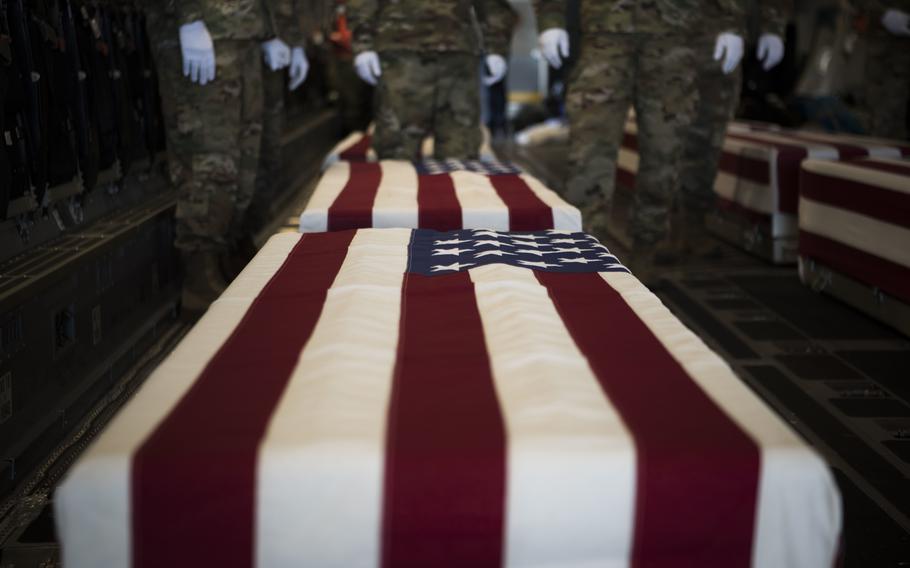
U.S. service members assigned to the Defense POW/MIA Accounting Agency stand by before a solemn movement ceremony at Joint Base Pearl Harbor-Hickam, Hawaii, in January 2018. The ceremony honored personnel lost in the Philippines during World War II. (Julian Temblador/U.S. Marine Corps)
A soldier missing in action since the Japanese invasion of the Philippines in World War II has been accounted for, 81 years after his death in a prisoner of war camp, the Pentagon reported Thursday.
Army Pvt. William E. Calkins, 20, of Washington County, Oregon, was identified April 17 by the Defense POW/MIA Accounting Agency using DNA and other recent scientific methods to match remains found in one of the common graves at the site of the former Cabanatuan camp where captured Americans troops were held in 1942.
Calkins’ remains will be buried with full military honors in Hillsboro, outside Portland, on Sept. 13, according to the U.S. Army Casualty Office.
Calkins was a soldier in Company B of the 31st Infantry Regiment when Japanese forces invaded the Philippine Islands in December 1941, according to Army records. American and Filipino forces fell back to the Bataan Peninsula and Corregidor Island before surrendering on May 6, 1942.
The U.S. listed Calkins in 1942 as among soldiers taken prisoner by the Japanese. Thousands of troops taken captive were forced to march to prison camps in what became known as the “Bataan Death March.”
Calkins was reported as a prisoner at Cabanatuan POW Camp #1. More than 2,500 POWs died in the camp before American troops and Filipino guerrillas recaptured the island between October 1944 and August 1945.
American and Filipino prisoners of war carry dead comrades after the Bataan Death March in May 1942. (National Archives)
According to prison camp and other historical records, Calkins died Nov. 1, 1942, and was buried along with other dead prisoners in Common Grave 704 at the Cabanatuan Camp Cemetery. He received the Bronze Star, Purple Heart and Prisoner of War medals for his service.
Following the war, American Graves Registration Service personnel exhumed those buried at Cabanatuan and took the remains to a U.S. military mausoleum where personnel attempted in 1947 to identify individuals. Only two of the 10 bodies in Common Grave 704 could be identified. The identified remains were reburied at the Manila American Cemetery and Memorial as Unknowns.
Advances in identification using DNA in recent years has led the Pentagon to launch renewed efforts under the DPAA to account for those previously classified as unidentifiable. In 2018, the Cabanatuan Project was launched to identify remains taken from common graves at prison camps.
Calkins’ remains were identified using dental and body analysis, the DPAA said.
Though interred as an unknown, Calkins’ grave was maintained by the American Battle Monuments Commission. His name is memorialized on the Wall of the Missing at the Manila American Cemetery and Memorial. A rosette will be placed next to his name to indicate he has been accounted for.
For information on Calkin’s funeral, contact the Army Casualty Office at (800) 892-2490.
For additional information on efforts to identifying Americans missing in action, go to www.dpaa.mil.
Calkins’ personnel profile can be viewed at https://dpaa-mil.sites.crmforce.mil/dpaaProfile?id=a0Jt0000000XfiiEAC.